Ray Optics MCQs
NEET Physics For Ray Optics And Optical Instruments Multiple Choice Questions
Question 1. An object is placed on the principal axis of a concave mirror at a distance of 1.5 f (f is the focal length). The image will be at:
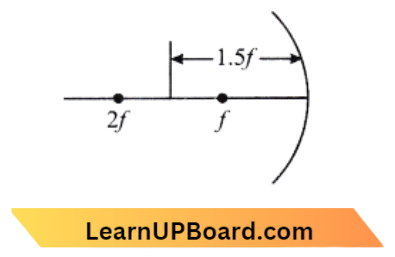
- -3f
- 15f
- -15f
- 3f
Answer: 1. -3f
From question, object distance,
u=-1.5 f
As we know,
The mirror formula is: \(\frac{1}{v}+\frac{1}{u} =\frac{1}{f} \)
⇒ \(\frac{1}{v}+\frac{1}{-1.5 f} =\frac{1}{-f} \)
⇒ \(\frac{1}{v} =-\frac{1}{f}+\frac{1}{1.5 f} \)
= \(\frac{1}{f}\left[-1+\frac{1}{1.5}\right] \)
= \(\frac{1}{f}\left[-1+\frac{2}{3}\right]\)
⇒ \(\frac{1}{v} =\frac{1}{f}\left(-\frac{1}{3}\right)=-\frac{1}{3 f}\)
v =-3 f.
Question 2. An object is placed at a distance of 40 cm from a concave mirror of a focal length of 15 cm. If the object is displaced through a distance of 20 cm towards the mirror, the displacement of the image will be :
- 30 cm towards the mirror
- 36 cm away from the mirror
- 30 cm away from the mirror
- 36 cm towards the mirror
Answer: 2. 36 cm away from the mirror
In this problem, we consider two cases,
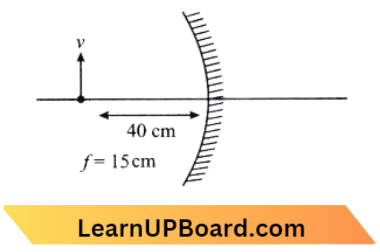
In Case (1)
When object is placed, \(u_1=-40 \mathrm{~cm}\) and focal length of mirror, f=-15 cm Using the mirror formula,
⇒ \(\frac{1}{f} =\frac{1}{v_1}+\frac{1}{u_1}\)
⇒ –\(\frac{1}{15} =\frac{1}{v_1}+\frac{1}{40}\)
⇒ \(\frac{1}{v_1}=\frac{1}{-15}+\frac{1}{40}=-\frac{5}{120}\)
∴ \(V_1=-24 \mathrm{~cm}\)
Case (2)
When an object is displaced by 20 cm towards the mirror
Then, \(u_2\)=-20
⇒ –\(\frac{1}{f} =\frac{1}{v_2}+\frac{1}{u_2}\)
⇒ –\(\frac{1}{15} =\frac{1}{v_2}-\frac{1}{20}\)
⇒ \(\frac{1}{v_2}=\frac{1}{20}-\frac{1}{15}=-\frac{1}{60}\)
⇒ \(v_2\)=-60 cm
So image shifts away from the mirror by =60-24=36 cm
Read and Learn More NEET Physics MCQs
Question 3. A beam of light from a source L is incident normally on a plane mirror fixed at a certain distance x from the source. The beam is reflected back as a spot on a scale placed just above the source L. When the mirror is rotated through a small angle of θ, the spot of the light is found to move through a distance y on the scale. The angle 0 is given by:
- \(\frac{y}{2 x}\)
- \(\frac{y}{x}\)
- \(\frac{x}{2 y}\)
- \(\frac{x}{y}\)
Answer: 1. \(\frac{y}{2 x}\)
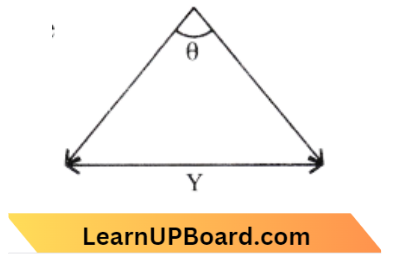
Given
A beam of light from a source L is incident normally on a plane mirror fixed at a certain distance x from the source. The beam is reflected back as a spot on a scale placed just above the source L. When the mirror is rotated through a small angle of θ, the spot of the light is found to move through a distance y on the scale.
⇒ \(\frac{Y}{x}=2 \theta\)
∴ \(\theta=\frac{Y}{2 x}\)
Ray Optics MCQs for NEET
Question 4. Match the corresponding entries of Column 1 with Column 2. [Where m is the magnification produced by the mirror]
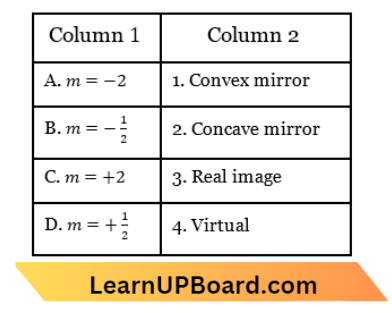
- A → 1 and 3; B → 1 and 4; C → 2 and 3; D →3 and 4
- A → 1 and 4; B → 2 and 3; C → 3 and 5; D → 2 and 3
- A → 3 and 4; B → 2 and 3; C → 2 and 3; D →1 and 4
- A → 2 and 3; B → 2 and 3; C → 3 and 4; D →3 and 4
Answer: 4. A → 2 and 3; B → 2 and 3; C → 3 and 4; D →3 and 4

⇒ \( m =+v_e\) (virtual image)
m =\(-v_e\) (real image)
∴ \(|m| <1\) (diminished image)
Question 5. Two plane mirrors are inclined at 70°. A ray incident on one mirror at angle θ, after reflection falls on the second mirror and is reflected from there parallel to the first mirror. The value of θ is:
- 45°
- 30°
- 55°
- 50°
Answer: 4. 50°
The actual situation is shown in the given degree,
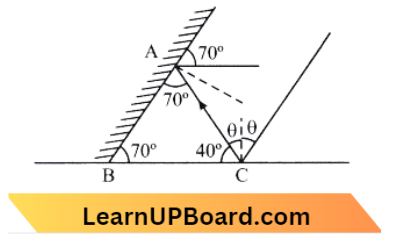
⇒ \(\theta+40^{\circ} =90^{\circ}\)
∴ \(\theta =90-40=50^{\circ}\)
Question 6. A concave mirror of focal length/ is placed at a distance of d from a convex lens of focal length l. A beam of light coming from infinity and falling on this convex lens concave mirror combination returns to infinity. The distance d must be equal:
- \(f_1+f_2\)
- –\(f_1+f_2\)
- \(2 f_1+f_2\)
- –\(2 f_1+f_2\)
Answer: 3. \(2 f_1+f_2\)
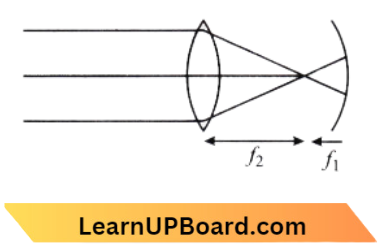
Given
A concave mirror of focal length/ is placed at a distance of d from a convex lens of focal length l. A beam of light coming from infinity and falling on this convex lens concave mirror combination returns to infinity.
\(d=2 f_1+f_2\)Ray Optics MCQs for NEET
Question 7. A rod of length 10 cm lies along the principal axis of a concave mirror of focal length 10 cm so that its end is closer to the pole 20 cm away from the mirror. The length of the image is:
- 10 cm
- 15 cm
- 2.5 cm
- 5 cm
Answer: 4. 5 cm
Image Position Of End A,

⇒ \(\frac{1}{v_A}+\frac{1}{-20} =\frac{1}{-10} \)
⇒ \(v_A \)=-20 cm
Image position of end B
⇒ \(\frac{1}{v_B}+\frac{1}{-30} =\frac{1}{-10}\)
⇒ \(v_B\) =-15 cm
The length of the image is
∴ \(\mathrm{A}^{\prime} \mathrm{B}^{\prime}=\left|v_A\right|-\left|v_B\right|=20-15=5 \mathrm{~cm}\)
Question 8. If two mirrors are kept inclined at 60° to each other and a body is placed in the middle, then the total number of images formed is:
- six
- five
- Four
- Three
Answer: 2. five
Many images are created when an object is held between two plane mirrors M1 and M2 inclined at (<θ) due to multiple reflections of light from the mirrors. The total number of images formed.
n=\(\frac{360^{\circ}}{\theta}-1\)
Here, \(\theta=60^{\circ}\)
n=\(\frac{360^{\circ}}{60^{\circ}}-1=6-1=5\)
Question 9. A light ray falls on a glass surface with a refractive index of √3″, at an angle of 60°. The angle between the refracted and reflected rays would be:
- 30°
- 60°
- 90°
- 120°
Answer: 1. 30°
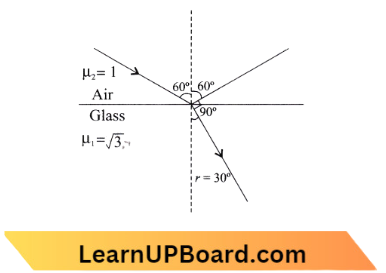
By Snell’s law, 1 \(\sin 60^{\circ} =\sqrt{3} \sin r\)
⇒ \(\frac{\sqrt{3}}{2} =\sqrt{3} \sin r\)
⇒ \(\sin r =\frac{1}{2}\)
r =\(30^{\circ}\)
MCQs on Ray Optics for NEET
Question 10. An air bubble in a glass slab with a refractive index of 1.5(near normal incidence) is 5 cm deep when viewed from one surface and 3 cm deep from the opposite face. The thickness (in cm) of the slab is:
- 8
- 10
- 12
- 16
Answer: 3. 12
Let, t= thickness of the glass slab.

From question, \(\frac{x}{\mu}+\frac{t-x}{\mu}\) =3+50
⇒ \(\frac{t}{\mu} =8 \mathrm{~cm}\)
t =\(\mu \times 8=8 \times \frac{3}{2}\)=12 cm
Question 11. A glass tube having a curved surface at one face is shown below with a refractive index of 1.5. Its center of the radius of curvature R lies inside the glass tube. If a particle is placed at point P. It forms the real image at point Q. The point O cuts PQ such that OP = 20Q then the value of OP is:
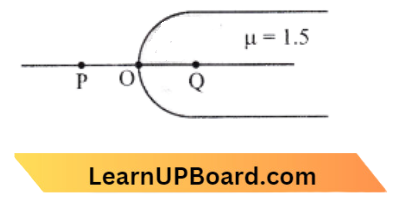
- 2R
- 4R
- 8R
- R
Answer: 3. 8R
Given
A glass tube having a curved surface at one face is shown below with a refractive index of 1.5. Its center of the radius of curvature R lies inside the glass tube. If a particle is placed at point P. It forms the real image at point Q.
When an object is in the rarer medium then
⇒ \(\frac{\mu_1}{v}=\frac{\mu_2}{u} =\frac{\mu_1-\mu_2}{R}\)
Now v =\(\mathrm{OQ} \)
u =\(\mathrm{OP}=-20 \mathrm{Q} \)
⇒ \(\frac{1.5}{\mathrm{OQ}}+\frac{1}{2 \mathrm{OQ}} =\frac{1.5-1}{R} \)
⇒ \(\frac{3+1}{2 \mathrm{OQ}} =\frac{0.5}{R}\)
⇒ \(\mathrm{OQ} \)=4 R
∴ \(\mathrm{OP} =20 \mathrm{Q}=2 \times 4 R=8 R\)
MCQs on Ray Optics for NEET
Question 12. The frequency of a light wave in a material is 2 × 1014 Hz and the wavelength is 5000 Å. The refractive index of the material will be:
- 1.50
- 3.00
- 1.33
- 1.40
Answer: 2. 3.00
Refractive index
⇒ \(\mu =\frac{c}{v \lambda} \)
∴ \(\mu =\frac{3 \times 10^8}{2 \times 10^{10} \times 5000 \times 10^{-10}}=3\)
Question 13. A small coin is resting on the bottom of a beaker filled with liquid. A ray of light from the coin travels up to the surface of the liquid and moves along its surface. How fast is the light traveling in the liquid?

- 2.4 \(\times 10^8 \mathrm{~m} / \mathrm{s}\)
- 3.0 \(\times 10^8 \mathrm{~m} / \mathrm{s}\)
- 1.2 \(\times 10^8 \mathrm{~m} / \mathrm{s}\)
- 1.8 \(\times 10^8 \mathrm{~m} / \mathrm{s}\)
Answer: 4. 1.8 \(\times 10^8 \mathrm{~m} / \mathrm{s}\)
⇒ \(\frac{1}{\mu}=\sin \theta_c=\frac{3}{5}\)
⇒ \(\mu=\frac{5}{3}\)
And v =\(\frac{c}{\mu}=\frac{3 \times 10^8}{5 / 3} [3 \times 10^8 \mathrm{~m} / \mathrm{s}]\)
= \(\frac{9}{5} \times 10^8=1.8 \times 10^8 \mathrm{~ms}^{-1}\)
Question 14. A beam of light composed of red and green rays is incident obliquely at a point on the face of a rectangular glass slab. When coming out on the opposite parallel face, the red and green-ray emerge from:
- two points prepared in two different nonparallel directions
- two points propagating in two different parallel directions
- one point propagating in two different directions
- one point propagating in the same directions
Answer: 2. two points propagating in two different parallel directions
Red and green rays emerge from two points propagating in two different parallel directions.
Question 15. Electromagnetic radiation of frequency v, velocity v, and wavelength \(\lambda\), in air, enters a glass slab of refractive index p. The frequency, wavelength, and velocity of light in the glass slab will be respectively:
- \(\frac{v}{\mu}, \frac{\lambda}{\mu}, v\)
- v,\( \lambda, \frac{v}{\mu}\)
- v, \(\frac{\lambda}{\mu}, \frac{v}{\mu}\)
- \(\frac{v}{\mu}, \frac{\lambda}{\mu}, \frac{v}{\mu}\)
Answer: 3. v, \(\frac{\lambda}{\mu}, \frac{v}{\mu}\)
When an electromagnetic wave travels through another medium, the frequency is unchanged, but the wavelength and velocity are \(\frac{1}{\mu}\) times.
Thus, after passing from air to a glass slab with a refractive index of \(\lambda\), frequency remains v, and wavelength remains \(\lambda^{\prime}=\frac{\lambda}{\mu}\) and velocity of light \(\mathrm{v}^{\prime}=\frac{\mathrm{v}}{\mu}\)
Class 12 Ray Optics MCQs
Question 16. Time taken by sunlight to pass through a window of 3 thickness 4 mm Whose refractive index is \(\frac{3}{2}\), is:
- \(2 \times 10^{-4} \mathrm{~s}\)
- 2 \(\times 10^8 \mathrm{~s}\)
- 2 \(\times 10^{-11} \mathrm{~s}\)
- 2 \(\times 10^{11} \mathrm{~s}\)
Answer: 3. 2 \(\times 10^{-11} \mathrm{~s}\)
Let x be the thickness of the window, v be the velocity of light entering the window, so the time taken by sunlight to pass through the window
t= \(\frac{x}{v}=\frac{x}{\frac{c}{\mu}}=\frac{\mu x}{c} \left[v=\frac{c}{\mu}\right]\)
t= \(\frac{1.5 \times 4 \times 10^{-3}}{3 \times 10^8}=2 \times 10^{-11} \mathrm{~s}\)
Question 17. A beam of monochromatic light is refracted from a vacuum into a medium with a refractive index of 1.5. The wavelength of refracted light will be:
- dependent on the intensity of refracted light
- same
- smaller
- larger
Answer: 3. smaller
We have, a refractive index,
⇒ \(\mu=\frac{\mathrm{c}}{\mathrm{v}}=\frac{\mathrm{v} \lambda_{\mathrm{v}}}{\mathrm{v} \lambda_{\mathrm{m}}}\)
As,c= velocity of light in vacuum
v = velocity of light in medium
⇒ \(\mathrm{v}=v \lambda\) and
v remains constant during refraction.
⇒ \(\lambda_{\mathrm{m}}=\frac{\lambda_{\mathrm{v}}}{\mu}\)
⇒ \(\lambda_{\mathrm{m}}<\lambda_{\mathrm{v}} ( \mu=1, \text { given })\)
Hence, in the second medium, the wavelength falls.
Class 12 Ray Optics MCQs
Question 18. Two transparent media A and B are separated by a plane boundary. The speed of light in those media are \(1.5 \times 10^8 \mathrm{~m} / \mathrm{s}\) and \(2.0 \times 10^8 \mathrm{~m} / \mathrm{s}\) respectively, The critical angle for a ray of light for these two media is:
- \(\sin ^{-1}(0.500)\)
- \(\sin ^{-1}(0.750)\)
- \(\tan ^{-1}(0.500)\)
- \(\tan ^{-1}(0.750)\)
Answer: 2. \(\sin ^{-1}(0.750)\)
Given
Two transparent media A and B are separated by a plane boundary. The speed of light in those media are \(1.5 \times 10^8 \mathrm{~m} / \mathrm{s}\) and \(2.0 \times 10^8 \mathrm{~m} / \mathrm{s}\) respectively,
For medium A, Speed of light \(v_{\mathrm{A}}=1.5 \times 10^8 \mathrm{~m} / \mathrm{s} \)
For medium B, Speed of light \(v_B=2.0 \times 10^8 \mathrm{~m} / \mathrm{s} \)
For medium \(\mathrm{A}, n_{\mathrm{A}}=\frac{C}{v_{\mathrm{A}}}=\frac{3 \times 10^8}{1.5 \times 10^8}\)=2
For medium \(\mathrm{B}, n_{\mathrm{B}}=\frac{C}{v_{\mathrm{B}}}=\frac{3 \times 10^8}{2 \times 10^8}\)=1.5
Critical angle, \(\sin c=\frac{n_{\mathrm{B}}}{n_{\mathrm{A}}}\)
c =\(\sin ^{-1}\left(\frac{1.5}{2}\right) \)
= \(\sin ^{-1}(0.750)\)
Question 19. If the critical angle for total internal reflection from a medium to vacuum is 45°, then the velocity of light in the medium is:
- 15 \(\times 10^8 \mathrm{~m} / \mathrm{s}\)
- \(\frac{3}{\sqrt{2}} \times 10^8 \mathrm{~m} / \mathrm{s}\)
- \(\sqrt{2} \times 10^8 \mathrm{~m} / \mathrm{s}\)
- 3 \(\times 10^8 \mathrm{~m} / \mathrm{s}\)
Answer: 2. \(\frac{3}{\sqrt{2}} \times 10^8 \mathrm{~m} / \mathrm{s}\)
It is given that critical angle \(i_c=45^{\circ}\).
We know \(\mu=\frac{1}{\sin i_{\mathrm{C}}}=\frac{1}{\sin 45^{\circ}}\)
= \(\frac{1}{\frac{1}{\sqrt{2}}}=\sqrt{2} \)
⇒ \(\frac{\text { Velocity of light in air }}{\text { Velocity of light in medium }}=\sqrt{2}\)
⇒ \(\frac{3 \times 10^8}{v_m}=\sqrt{2}\)
∴ \(v_m=\frac{3}{\sqrt{2}} \times 10^8 \mathrm{~m} / \mathrm{s}\) .
Question 20. In total internal reflection when the angle of incidence is equal to the critical angle for the pair of media in contact, what will be the angle of refraction?
- 0°
- Equal to the angle of incidence
- 90°
- 180°
Answer: 3. 90°
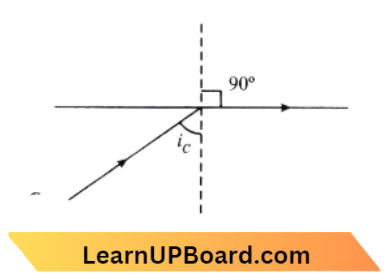
At i=\(i_c\), refracted ray grazes with the surface.
So, the angle of refraction is \(90^{\circ}\).
Class 12 Ray Optics MCQs
Question 21. Which of the following is not due to total internal reflection?
- Difference between apparent and real depth of a pond.
- Mirage on hot summer days.
- Brilliance of diamond.
- Working of optical fiber.
Answer: 1. Difference between the apparent and real depth of a pond
The difference between the apparent and real depth of a pond is not due to internal reflection.
Question 22. A ray of light traveling in a transparent medium of refractive index μ falls, on the surface separating the medium from air at an angle of incidence of 45°. For which of the following values of p the ray can undergo total internal reflection?
- μ = 1.33
- μ = 1.40
- μ = 1.50
- μ = 1.25
Answer: 3. μ = 1.50
We know that, for total internal reflection
⇒ \(\sin i>\sin c\)
⇒ \(\sin 45^{\circ}>\frac{1}{\mu}\)
⇒ \(\mu>\sqrt{2} \)
∴ \(\mu>1.4\)
Question 23. The speed of light in medium M1 and M2 is 1.5 x 108 m/s and 2.0 x 108 m/s respectively. A ray of light enters from medium M1 to M2 at an incidence angle I, if the ray suffers total internal reflection the value of i is:
- equal to sin\(1^{-1}\left(\frac{2}{3}\right)\)
- equal to or less than sin\(\mathrm{n}^{-1}\left(\frac{3}{5}\right)\)
- equal to or greater than\(\sin ^{-1}\left(\frac{3}{4}\right)\)
- less than sin\(\mathrm{a}^{-1}\left(\frac{2}{3}\right)\)
Answer: 3. equal to or greater than\(\sin ^{-1}\left(\frac{3}{4}\right)\)
We know that in total internal reflection the angle of incidence i is greater than critical angle C.
i >C
2 \(\mu_1 =2 and \mu_2=\frac{3}{2}\)
⇒ \(2 \sin i \geq \frac{3}{2} \sin 90^{\circ}\)
⇒ \(\sin i \geq \frac{3}{4}\)
i \(\geq \sin ^{-1}\left(\frac{3}{4}\right)\)
Class 12 Ray Optics MCQs
Question 24. A boy is trying to start a fire by focusing sunlight on a piece of paper using a biconvex lens with a focal length of 10 cm. The diameter of the sun is \(1.39 \times 10^9\)m and its mean distance from the earth is \(1.5 \times 10^{11}\) m. What is the diameter of the sun’s image on the paper?
- \(9.2 \times 10^{-4} \mathrm{~m}\)
- 6.5 \(\times 10^{-4} \mathrm{~m}\)
- 6.5 \(\times 10^{-5} \mathrm{~m}\)
- 12.4 \(\times 10^{-4} \mathrm{~m}\)
Answer: 1. \(9.2 \times 10^{-4} \mathrm{~m}\)
Given
A boy is trying to start a fire by focusing sunlight on a piece of paper using a biconvex lens with a focal length of 10 cm. The diameter of the sun is \(1.39 \times 10^9\)m and its mean distance from the earth is \(1.5 \times 10^{11}\) m.
From the relation, \(\frac{I}{O}=\frac{v}{u}\)
Here, \(\mathrm{O}=1.39 \times 10^9\)
and v=0.1 \(\mathrm{~m}\)
u=1.5 \(\times 10^{11} \mathrm{~m}\)
I =\(\frac{0.1}{1.5 \times 10^{11}} \times 1.39 \times 10^9\)
= 9.2 \(\times 10^{-4} \mathrm{~m}\)
Question 25. A convex lens and a concave lens, each having the same focal length of 25 cm, are put in contact to form a combination of lenses. The power in diopters of the combination is:
- zero
- 25
- 50
- infinite
Answer: 1. zero
The focal length of the lens
⇒ \(f_1\)=25 cm
focal length of concave lens
⇒ \(f_2\)=25 cm
Power of combination in dioptres
P=\(P_1+P_2\)
P=\(\frac{100}{f_1}+\frac{100}{f_2}\)
P=\(\frac{100}{25}+\frac{100}{-25}\)=0
Important MCQs on Ray Optics for NEET
Question 26. A biconvex lens has radii of curvature, 20 cm each. If the refractive index of the material of the lens is 1.5, the power of the lens is:
- + 2D
- + 20 D
- + 5 D
- infinity
Answer: 3. + 5 D
Given: u=1.5, \(R_1=+R, R_2=-R_I=-R\)
⇒ \(R_1=+20\) cm and \(R_2=-20\) cm
Lens maker’s formula, \(\frac{1}{f}=(u-1)\left(\frac{1}{R_1}-\frac{1}{R_2}\right)\)
⇒ \(\frac{1}{f}=(1.5-1)\left(\frac{1}{20}-\frac{1}{(-20)}\right)\)
⇒ \(\frac{1}{f}=0.5\left(\frac{1}{20}+\frac{1}{20}\right) \)
⇒ \(\frac{1}{f}=\frac{1}{20} \)
f = 20 cm
Now Power, P=\(\frac{100}{20}=5 \mathrm{D}\)
Question 27. A point object is placed at a distance of 60 cm from a convex lens of focal length 30 cm. If a plane mirror were put perpendicular to the principal axis of the lens and at a distance of 40 cm from it, the final image would be formed at a distance of:
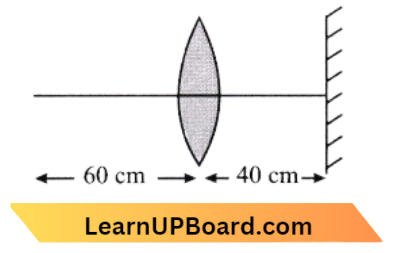
- 20 cm from the lens, it would be a real image
- 30 cm from the lens, it would be a real image
- 30 cm from the plane mirror, it would be a virtual image
- 20 cm from the plane mirror, it would be a virtual image
Answer: 4. 20 cm from the plane mirror, it would be a virtual image
Using the lens formula for the first refraction from the convex lens,
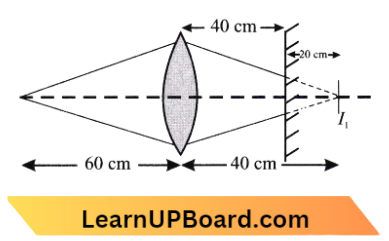
⇒ \(\frac{1}{v_1}-\frac{1}{u} =\frac{1}{f} \)
⇒ \(v_1\)=?, u =-60 cm, f=30 cm
⇒ \(\frac{1}{v_1}+\frac{1}{60} =\frac{1}{30} \)
⇒ \(v_1\) =60 cm
Here \(I_1\) is the first image by the lens,
The plane mirror will produce an image at a distance of 20 cm to the left of it.
For the second refraction from a convex lens,
u=-20 cm, v=?, f=30 cm
From lens formula, \(\frac{1}{v}-\frac{1}{(-20)} =\frac{1}{30} \)
v =-60 cm
Thus, the final image is virtual and at a distance, of 60 cm – 40 cm=20 cm from the plane mirror.
Important MCQs on Ray Optics for NEET
Question 28. A convex lens ‘A’ with a focal length of 20 cm and a concave lens ‘B’ with a focal length of 5 cm is kept along the same axis with a distance between them. If a parallel beam of light falling on ‘A’ leaves ‘B’ as a parallel beam, then the distance ‘cT in cm will be:
- 25
- 15
- 50
- 30
Answer: 2. 15
Given,
A convex lens ‘A’ with a focal length of 20 cm and a concave lens ‘B’ with a focal length of 5 cm is kept along the same axis with a distance between them. If a parallel beam of light falling on ‘A’ leaves ‘B’ as a parallel beam
Focal length of A=\(f_{\mathrm{A}}=+20 \mathrm{~cm}\) [convex]
Focal length of B=\(f_{\mathrm{B}}=-5 \mathrm{~cm}\) [concave]
distance between A and B=d
For a parallel beam of light entering A to remain parallel while exiting B.
The net focal length of the combination should be infinite.
⇒ \(\frac{1}{f}=\frac{1}{f_{\mathrm{A}}}+\frac{1}{f_{\mathrm{B}}}-\frac{d}{f_{\mathrm{A}} f_{\mathrm{B}}}\) =0
⇒ \(\frac{1}{20}-\frac{1}{5}+\frac{d}{100}\) =0
⇒ –\(\frac{15}{100}+\frac{d}{100} \)=0
d =15 cm
Question 29. A piano convex lens of unknown material and unknown focal length is given. With the help of a spherometer, we can measure the:
- focal length of the lens
- radius of curvature of the curved surface
- the aperture of the lens
- the refractive index of the material
Answer: 2. radius of curvature of the curved surface
The first known spherometer was invented by French Optician Robert Aglae Cauchoix in 1810. They were manufactured starting in the nineteenth century primarily for the use of opticians in grinding lenses and curved mirrors.
Question 30. The power of a biconvex lens is 10 D and the radius of curvature of each surface is 10 cm. Then, the refractive index of the material of the lens is:
- \(\frac{4}{3}\)
- \(\frac{9}{8}\)
- \(\frac{5}{3}\)
- \(\frac{3}{2}\)
Answer: 4. \(\frac{3}{2}\)
From the question power of the biconvex lens,
P =\(10 \mathrm{D}\)
f =\(\frac{1}{P}=\frac{1}{10}=0.1 \mathrm{~m}=10 \mathrm{~cm} \)
⇒ \(R_1 =R_2=10 \mathrm{~cm}\)
Now from the lens maker’s formula
⇒ \(\frac{1}{f} =(\mu-1)\left(\frac{1}{R_1}-\frac{1}{R_2}\right) \)
⇒ \(\frac{1}{10} =(\mu-1)\left(\frac{1}{10}-\frac{1}{-10}\right) \)
⇒ \(\frac{1}{10} =(\mu-1)\left(\frac{2}{10}\right)\)
1 =\((\mu-1) \times 2 \)
⇒ \(\mu-1 =\frac{1}{2} \)
∴ \(\mu =1+\frac{1}{2}=\frac{3}{2}\)
Important MCQs on Ray Optics for NEET
Question 31. Two similar thin equi-convex lenses, of focal length / each, are kept co-axially in contact with each other such that the focal length of the combination is F1. When the space between the two lenses is filled with glycerine which has the same refractive index (μ = 15) as that of glass then the equivalent focal length is F2. The ratio F1 : F2 will be:
- 1:2
- 2:3
- 3:4
- 2:1
Answer: 1. 1:2
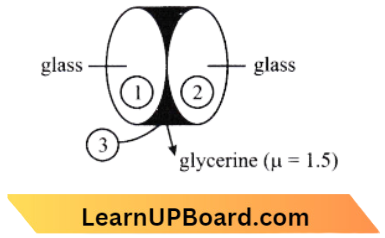
Given
Two similar thin equi-convex lenses, of focal length / each, are kept co-axially in contact with each other such that the focal length of the combination is F1. When the space between the two lenses is filled with glycerine which has the same refractive index (μ = 15) as that of glass then the equivalent focal length is F2.
First, find the focal length of the lens (1),
⇒ \(\frac{1}{f_1}=\left(\frac{\mu_2}{\mu_3}-1\right)\left(\frac{1}{\mathrm{R}_1}-\frac{1}{\mathrm{R}_2}\right)\mathrm{L}\)= Lens
S = Surrounding
⇒ \(R_1\)= Radius of first surface
⇒ \(R_2\)= Radius of 2nd surface
⇒ \(\frac{1}{f_1} =\left(\frac{1.5}{1}-1\right)\left(\frac{1}{R}-\frac{1}{-R}\right)\)
=\(\frac{1}{2} \times \frac{2}{R}=\frac{1}{R}\)
Now focal length of (2),
⇒ \(\frac{1}{f_2}=\left(\frac{1.5}{1}-1\right)\left(\frac{1}{R}-\frac{1}{-R}\right)=\frac{1}{R}\)
The combination of these two
⇒ \([latex]\frac{1}{F_1}=\frac{1}{f_2}+\frac{1}{f_2}=\frac{1}{R}+\frac{1}{R}=\frac{2}{R} \)
⇒ \(F_1=\frac{R}{2}\)
Now focal length of concave (3)
⇒ \(\frac{1}{f_3} =\left(\frac{\mu_2}{\mu_3}-1\right)\left(\frac{1}{R_1}-\frac{1}{R_2}\right)\)
⇒ \(\frac{1}{f_3} =\left(\frac{1.5}{1}-1\right)\left(-\frac{1}{R}-\frac{1}{R}\right) \)
= \(\frac{1}{2} \times \frac{-2}{R} \)
=-\(\frac{1}{R}\)
Focal length, \(\frac{1}{F_2} =\frac{1}{f_1}+\frac{1}{f_2}+\frac{1}{f_3} \)
⇒ \(\frac{1}{F_2} =\frac{1}{R}+\frac{1}{R}-\frac{1}{R}=\frac{1}{R} \)
⇒ \(F_2 \)=R
According to the question,
∴ \(\frac{F_1}{F_2}=\frac{R / 2}{R}=\frac{R}{2 \times R}=\frac{1}{2}\)
Question 32. An equi-convex lens has power P. It is cut into two symmetrical halves by a plane containing the principal axis. The power of one part will be:
- 0
- \(\frac{P}{2}\)
- \(\frac{P}{4}\)
- P
Answer: 3. \(\frac{P}{4}\)
In both cases (1) and (2) focal length does not change. Hence power does not change. So, the power of one part is also P.
Important MCQs on Ray Optics for NEET
Question 33. A double convex lens has a focal length of 25 cm. The radius of curvature of one of the surfaces is doubled that of the other. Find the radii, if the refractive index of the material of the lens is 1.5:
- 100 cm. 50 cm
- 25 cm. 50 cm
- 18.75 cm. 37.5 cm
- 50 cm, 100 cm
Answer: 3. 18.75 cm. 37.5 cm
Focal length of lens is, \(\frac{1}{f} =(\mu-1)\)
⇒ \(\frac{1}{25} =(1.5-1)\left(\frac{1}{R}+\frac{1}{2 R}\right)\)
⇒ \(\frac{1}{25} =0.5\left(\frac{3}{2 R}\right)\)
2 R =37.5 \(\mathrm{~cm} \)
R =18.75 \(\mathrm{~cm}\)
Hence radii are 18.75 \(\mathrm{~cm}, 37.5 \mathrm{~cm}\).
Question 34. Two identical glass (\(\mu_g\) = 3/2) equi-convex lenses of focal length f each are kept in contact. The space between the two lenses is filled with water (\(\mu_w\) = 4/3). The focal length of the combination is:
- f/3
- f
- \(\frac{4 f}{3}\)
- \(\frac{3 f}{4}\)
Answer: 4. \(\frac{3 f}{4}\)
The diagram shows the actual situation

Let R = Radius of curvature of the lens
and \(\frac{1}{f_{e q}}=\frac{1}{f_1}+\frac{1}{f_2}+\frac{1}{f_3}\left\{ f_1=f_3\right\}\)
⇒ \(f_1=f_3=\frac{R}{2\left(\frac{3}{2}-1\right)}=R=f \text { (given) } \)
⇒ \(f_2=\frac{-R}{2\left(\frac{4}{3}-1\right)}=-\frac{3}{2} R=\frac{3}{2} f \)
⇒ \(\frac{1}{f_{\text {eq }}}=\frac{1}{f_1}+\frac{1}{f_2}+\frac{1}{f_3} \)
⇒ \(\frac{1}{f_{\text {eq }}}=\frac{1}{f}+\left(-\frac{2}{3 f}\right)+\frac{1}{f}\)
⇒ \(\frac{1}{f_{e q}}=\frac{4}{3 f} \)
∴ \(f_{e q}=\frac{3 f}{4} \)
Important MCQs on Ray Optics for NEET
Question 35. A person can see clearly objects only when they lie between 50 cm and 400 cm from his eyes. In order to increase the maximum distance of distinct vision to infinity, the type and power of the correcting lens, the person has to use, will be:
- convex, + 2.25 diopter
- concave, – 0.25 diopter
- concave – 0.2 diopoter
- convex, + 0.15 diopter
Answer: 2. concave, – 0.25 diopter
As we want to correct myopia. So, the far point must go to infinity.
V =-4 \(\mathrm{~m}, u=\infty\), P=?
P =\(\frac{1}{f}=\frac{1}{v}-\frac{1}{u}\)
=\(\frac{1}{-4}-\frac{1}{\infty}=-0.25 \mathrm{D}\)
∴ – ve sign indicates that the mirror is concave.
Question 36. Two identical thin plano-convex glass lenses (refractive index 1.5) each having a radius of curvature of 20 cm are placed with their convex surface in contact at the center. The intervening space is filled with oil with a refractive index of 1.7. The focal length of the combination is:
- – 20 cm
- – 25 cm
- – 50 cm
- 50 cm
Answer: 3. – 50 cm
The radius of curvature of plano-convex lensR:20 cm Refractive index of plano-convex lens μ: 1.5 Using mirror formula
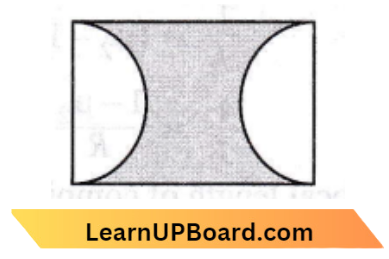
⇒ \(\frac{1}{f}=(\mu-1)\left[\frac{1}{R}\right] \)
⇒ \(\frac{1}{f}=(1.5-1) \cdot \frac{1}{R}\)
⇒ \(\frac{1}{f}=\frac{0.5}{R}\)
focal length, \(\frac{1}{f_{\text {concave }}} =\left(\mu_1-1\right)\left(-\frac{1}{2}-\frac{1}{2}\right)\)
= \((1.7-1)\left[-\frac{1}{R}-\frac{1}{R}\right]\)
⇒ \(\frac{1}{f_{\text {concave }}} =\frac{-0.7 \times 2}{R}=-\frac{1.4}{K}\)
Equivalent focal length will be
⇒ \(\frac{1}{f_{\text {eq }}}=\frac{0.5}{R}-\frac{1.4}{R}+\frac{0.5}{R}=-\frac{0.4}{R}\)
∴ \(f_{e q}=-50 \mathrm{~cm}\)
Question 37. If the focal length of the objective lens is increased, then the magnifying power of:
- the microscope will increase but that of the telescope decrease
- microscope and telescope both will increase
- microscope and telescope both will decrease
- microscope will decrease but that of the telescope will increase.
Answer: 4. The microscope will decrease but that of the telescope will increase.
Focal length m \(\propto \frac{1}{f_0}\) microscope
⇒ \(\frac{f_0}{f_e}=m \)
m\( \propto f_0 \)telescope
The magnifying power of the microscope decreases and the magnifying power of the telescope increases.
Physics MCQs for NEET with Answers
Question 38. A plano-convex lens fits exactly into a plano-concave lens. Their plane surface is parallel to each other. If lenses are made of different materials of refractive indices \(\mu_1\) and \(\mu_2\) and R is the radius of curvature of the curved surface of the lenses, then the focal length of the combination is:
- \(\frac{R}{2\left(\mu_1+\mu_2\right)}\)
- \(\frac{R}{2\left(\mu_1-\mu_2\right)}\)
- \(\frac{R}{\left(\mu_1-\mu_2\right)}\)
- \(\frac{2 R}{\left(\mu_2-\mu_1\right)}\)
Answer: 3. \(\frac{R}{\left(\mu_1-\mu_2\right)}\)
Given
A plano-convex lens fits exactly into a plano-concave lens. Their plane surface is parallel to each other. If lenses are made of different materials of refractive indices \(\mu_1\) and \(\mu_2\) and R is the radius of curvature of the curved surface of the lenses,
Lens maker formula: \(\frac{1}{f}=(\mu-1)\left(\frac{1}{R_1}-\frac{1}{R_2}\right)\) → Equation 1
For Plano-convex lens: \(R_1=\infty, R_2=-R\)
Using (1), \(\frac{1}{f_1}=\left(\mu_1-1\right)\left(\frac{1}{\infty}-\frac{1}{-R}\right)\)
⇒ \(\frac{1}{f_1}=\frac{\mu_1-1}{R} \)
For Plano-concave lens: \(R_1=-R, R_2=\infty\) Using (2),
⇒ \(\frac{1}{f_2}=\left(\mu_2-1\right)\left(\frac{1}{-R}-\frac{1}{\infty}\right)\)
\(\frac{1}{f_2}=\frac{1-\mu_2}{R}\)Thus focal length of the combination,
⇒ \(\frac{1}{F} =\frac{1}{f_1}+\frac{1}{f_2}=\frac{\mu_1-1}{R}+\frac{1-\mu_2}{R}\)
F =\(\frac{R}{\mu_1-\mu_2}\)
Question 39. For a normal eye, the corneas of the eye provide a converging power of 40 D, and the least converging power of the eye lens behind the cornea is 20 D. Using this information, the distance between the retina and the cornea-eye lens can be estimated to be:
- 5 cm
- 2.5 cm
- 1.67 cm
- 1.5 cm
Answer: 3. 1.67 cm
Given
For a normal eye, the corneas of the eye provide a converging power of 40 D, and the least converging power of the eye lens behind the cornea is 20 D. Using this information,
For a normal eye rays coming from the infinite should go to the retina without effort when we look at infinity, the lens offers minimum power and hence combination gives 40D + 20D = 60D.
Distance between the retina and the cornea of the eye must be equal to focal length \(f=\frac{1}{60} \mathrm{~m}=1.67 \mathrm{~cm}\)
Physics MCQs for NEET with Answers
Question 40. When a biconvex lens of glass has refractive. index 1.47 is dipped in a liquid, it acts as a plane sheet of glass. This implies that the liquid must have a refractive index:
- equal to that of glass
- less than one
- greater than that of glass
- less than that of glass
Answer: 1. equal to that of glass
According to the question,

and \(\mu_g \)=1.47
f =\(\infty\)
Using the formula,
⇒ \(\frac{1}{f} =(\mu-1)\left(\frac{1}{R_1}-\frac{1}{R_2}\right)\)
= \(\left(\frac{\mu_g}{\mu_2}\right)\left(\frac{1}{R_1}-\frac{1}{R_2}\right)\)
⇒ \( \frac{1}{\infty} =\left(\frac{\mu_g}{\mu_2}-1\right)\left(\frac{1}{R_1}-\frac{1}{R_2}\right) \)
0 =\(\left(\frac{\mu_g}{\mu_2}-1\right)\left(\frac{1}{\mathrm{R}_1}-\frac{1}{\mathrm{R}_2}\right)\)
Since \(\left(\frac{1}{R_1}-\frac{1}{R_2}\right) \neq 0\)
⇒ \((\frac{\mu_g}{\mu_2}-1)\)=0
⇒ \(\frac{\mu_g-\mu_2}{\mu_2}\)=0
This shows that the liquid must have a refractive index equal to that of glass.
Physics MCQs for NEET with Answers
Question 41. A biconvex lens has a radius of curvature of magnitude 20 cm. Which one of the following options describes best the image formed of an object height of 2 cm placed 20 cm from the lens?
- Virtual, upright, height = 0.5 cm
- Real, inverted, height = 4 cm
- Real, inverted, height = 1 cm
- Virtual, upright, height = 1 cm
An⇒swer: 2. Real, inverted, height = 4 cm
Here,\(\mu\)=1.5 (considered)
f=20 cm
and Using the formula,
⇒ \(\frac{1}{f}=\frac{1}{v}+\frac{1}{u}\)
⇒ \(\frac{1}{20}=\frac{1}{v}+\frac{1}{30}\)
⇒ \(\frac{1}{v}=\frac{1}{20}-\frac{1}{30}=\frac{100}{600}\)
v=60 m
Question 42. A converging beam of rays is incident on a diverging lens. Having passed through the lens the rays intersect at a point 15 cm from the lens on the opposite side. If the lens is removed the point where the rays meet will move 5 cm closer to the lens. The focal length of the lens is:
- – 10 cm
- 20 cm
- – 30 cm
- 5cm
Answer: 3. 20 cm
In the question, u=10 \(\mathrm{~cm}\), v=15 \(\mathrm{~cm}\), f= ?
⇒ \(\frac{1}{f} =\frac{1}{v}-\frac{1}{u}\)
= \(\frac{1}{15}-\frac{1}{10}=\frac{10-15}{150}=-\frac{5}{150} \)
⇒ \(\frac{1}{f} =-\frac{1}{30} \)
f=-30
Question 43. A lens having focal length l and an aperture of diameter of d forms an image of intensity I. The aperture of diameter \(\frac{d}{2}\) in the central region of the lens is covered by black paper. The focal length of the lens and intensity of the image now will be respectively:
- f and \(\frac{I}{4}\)
- \(\frac{3 f}{4}\) and \(\frac{I}{2}\)
- f and \(\frac{3 I}{4}\)
- \(\frac{f}{2} and \frac{I}{2}\)
Answer: 3. f and \(\frac{3 I}{4}\)
We know that,Intensity \(\mathrm{I} \propto \mathrm{A}^2\) then
⇒ \(\frac{I_2}{I_1} =\left[\frac{A_2}{A_1}\right]^2=\frac{\pi r^2-\frac{\pi r^2}{4}}{\pi r^2}=\frac{3}{4} \)
∴ \(I_2 =\frac{3}{4} I_1\)
Physics MCQs for NEET with Answers
Question 44. Two thin lenses of focal lengths f1 and f2 are in contact and coaxial.mtrThe power of the combination is;
- \(\sqrt{\frac{f_1}{f_2}}\)
- \(\sqrt{\frac{f_2}{f_1}}\)
- \(\frac{f_1+f_2}{f_1 f_2}\)
- \(\frac{f_1-f_2}{f_1 f_2}\)
Answer: 3. \(\frac{f_1+f_2}{f_1 f_2}\)
We can write,
⇒ \(P=P_1+P_2 \)
P=\(\frac{1}{f_1}+\frac{1}{f_2} \)
P=\(\frac{f_1+f_2}{f_1 f_2}\)
Question 45. A convex lens is dipped in a liquid whose refractive index is equal to the refractive index of the lens. Then its focal length will:
- become zero
- become infinite
- become small, but non-zero
- remain unchanged
Answer: 2. become infinite
When the refractive index of the lens is equal to the refractive index of the liquid, the lens behaves like a plane surface with a focal length of infinity.
Question 46. An equiconvex lens is cut into two halves along (1) XOX’ and (2) YOY as shown in the figure. Let f,f’,f” be the focal length of the complete lens, of each half in case (1) and each half in case (2), respectively. Choose the correct statement from the following:
![]()
- f’: f, f”:2f
- f’ :2f, f” : f
- f’: f, f”: f
- f’ :2f, f” :2f
Answer: 1. f’: f, f”:2f
Since the lens is biconvex, the radius of curvature of each half is the same.

Using the lens maker formula,
⇒ \(\frac{1}{f}=(\mu-1)\left(\frac{1}{R_1}-\frac{1}{R_2}\right)\)
Here,\( R_2\)=-R by convection
⇒ \(\frac{1}{f}=(\mu-1) \frac{2}{\mathrm{R}},(\mu-1) \frac{1}{\mathrm{R}}=\frac{1}{2 f}\)
If we cut the lens along X O\( X^{\prime}\) then two halves of the lens will have the same radii of curvature and
⇒ \(R_1=R, R_2=-R\)
⇒ \(\frac{1}{f^{\prime}}=(\mu-1)\left(\frac{2}{R}\right)\)
⇒ \(\frac{1}{f},=\frac{2}{2 f}=\frac{1}{f}\)
From (1) it is clear that\( f^{\prime}\)=f
But when we cut along YOY’ then
⇒ \(R_1=R\) and \(R_2=\infty \)
⇒ \(\frac{1}{f^n} =(\mu-1)\left(\frac{1}{R}-\frac{1}{\infty}\right)\)
=\((\mu-1) \frac{1}{R}=\frac{1}{2 f}\)
∴ \(f^{\prime \prime} \)=2 f
Chapter-Wise MCQs for NEET Physics
Question 47. A bulb is located on a wall. Its image is to be obtained on a parallel with the help of a convex lens. If the distance between parallel walls is then the required focal length of the lens placed in between the walls is:
- only \(\frac{d}{4}\)
- only \(\frac{d}{2}\)
- more than \(\frac{d}{4} but less than \frac{d}{2}\)
- less than or equal to \(\frac{d}{4}\)
Answer: 4. less than or equal to \(\frac{d}{4}\)
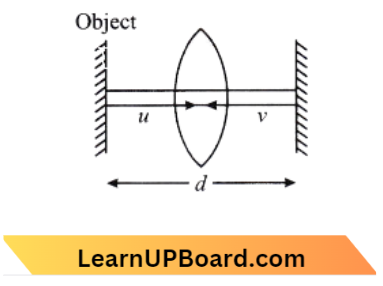
Since , v+u =d
v =d-u
From lens formula, \(\frac{1}{f} =\frac{1}{v}-\frac{1}{u}\)
⇒ \(\frac{1}{f} =\frac{1}{d-u}-\frac{1}{-u} \)
= \(\frac{d}{(d-u) u} \)
f =\(\frac{d u-u^2}{d}\) → Equation 1
Differentiating eq. (1) we have,
⇒ \(\frac{d f}{d u}=\frac{1}{d}(d-2 u)\)
for maximum value of \(f_1=\frac{d f}{d u}\)=0
⇒ \(\frac{1}{d}(d-2 u)\) =0
d =2 u
u =\(\frac{d}{2}\)
putting these values in eq. (1),
f=\(\frac{d}{4}\)
Chapter-Wise MCQs for NEET Physics
Question 48. A planoconvex lens is made of a material with a refractive index μ = 1.5. The radius of curvature of the curved surface of the lens is 20 cm. If its plane surface is silvered, the focal length of the silvered lens will be:
- 10 cm
- 20 cm
- 40 cm
- 80 cm
Answer: 2. 20 cm
Since, v+u =d
v =d-u
From lens formula
⇒ \(\frac{1}{f} =\frac{1}{v}-\frac{1}{u}\)
⇒ \(\frac{1}{f} =\frac{1}{d-u}-\frac{1}{-u} \)
=\(\frac{d}{(d-u) u} \)
f =\(\frac{d u-u^2}{d}\) → Equation 1
Differentiating eq. (1) we have,
⇒ \(\frac{d f}{d u}=\frac{1}{d}(d-2 u)\)
for maximum value of \(f_1=\frac{d f}{d u}\)=0
⇒ \(\frac{1}{d}(d-2 u)\) =0
d =2 u
u =\(\frac{d}{2}\)
putting these values in eq. (1),
f=\(\frac{d}{4}\)
When a ray strikes the convex surface of a planoconvex lens, it is first refracted and then reflected from the plane surface, then refracted from the convex surface. As a result, there are two refractions and one reflection. Since re&action and reflection occur twice, and reflection occurs at the same time. So, the focal length of a planoconvex lens \(\frac{1}{F}=\frac{2}{f_1}+\frac{1}{f_m}\)
If the plane surface is silvered, then
⇒\(\mathrm{f}_{\mathrm{m}}=\frac{\mathrm{R}_2}{2}=\frac{\infty}{\mathrm{f}_{\mathrm{m}}}\) → Equation 1
by lens maker formula,
⇒ \(\frac{1}{f_1}=(\mu-1)\left(\frac{1}{R_1}-\frac{1}{R_2}\right) \)
= \((\mu-1)\left(\frac{1}{R}-\frac{1}{\infty}\right)=\frac{(\mu-1)}{R}\)
⇒ \(\frac{1}{F}=\frac{2(\mu-1)}{R}+\frac{1}{\infty}\)
= \(\frac{R}{2(\mu-1)} \)
or F=\(\frac{R}{2(\mu-1)}\)
Given, R=20 \(\mathrm{~cm}, \mu\)=1.5
Hence, F =\(\frac{20}{2(1.5-1)}=\frac{20}{2 \times 0.5} \)
=20 cm
Chapter-Wise MCQs for NEET Physics
Question 49. A planoconvex lens is made of material with a refractive index of 1.6. The radius of curvature of the curved surface is 60 cm. The focal length of the lens is:
- 50 cm
- 100 cm
- 200 cm
- 400 cm
Answer: 2. 100 cm
By lens maker formula,\(\frac{1}{f}=(\mu-1)\left(\frac{1}{R_1}-\frac{1}{R_2}\right)\) → Equation 1
We have, the radius of curvature of a plane surface for a planoconvex lens is infinite.
i.e., \(R_2=\infty \)
⇒ \(R_1=60 \mathrm{~cm}, \mu=1.6\)
Given,\(\mathrm{R}_1=60 \mathrm{~cm}, \mu\)=1.6
Substituting the given values in Eq. (1), we get
⇒ \(\frac{1}{f} =(1.6-1)\left(\frac{1}{60}-\frac{1}{\infty}\right)=0.6 \times \frac{1}{60}\)
=100 cm
The focal length of plane convex lens is 100 \(\mathrm{~cm}\)
Question 50. A convex lens of focal length 80 cm and a concave lens of focal length 50 cm are combined. What will be their resulting power?
- + 6.5 D
- -6.5 D
- + 7.5 D
- -0.75 D
Answer: 4. -0.75 D
The ability of a lens to converge a beam of light falling on it is known as the power of the lens. It is measured as the reciprocal of the focal length of the lens.
⇒ \(\mathrm{P}=\frac{1}{f_{\text {(in } \mathrm{m})}}\)
When focal length is in \mathrm{cm}, \(\mathrm{P}=\frac{100}{f} \mathrm{D}\)
Here,\(f_1\)=80 \mathrm{~cm}, \(f_2=-50 \mathrm{~cm}\)
we have, the combined power of two lenses
⇒ \(P_{\text {eq }} =P_1+P_2 \)
⇒ \(\mathrm{P}_{\text {eq }} =\frac{1}{f_1(\mathrm{~m})}+\frac{1}{f_2(\mathrm{~m})}\)
∴ \(\mathrm{P} =\frac{100}{80}-\frac{100}{50}=-0.75 \mathrm{D}\)
Question 51. The value of the angle of emergence from the prism, when the refractive index of the glass is \(\sqrt{3}\); is:
- 60°
- 35°
- 45°
- 90°
Answer: 4. 90°
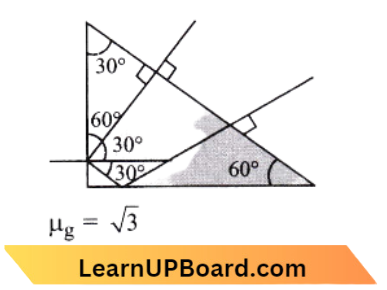
⇒ \(\mu_{\mathrm{g}}=\sqrt{3}\)
We know, \(\sin i_c =\frac{\mu_a}{\mu_g}=\frac{1}{\mu_g} \)
⇒ \(i_c =\sin ^{-1}\left(\frac{1}{\mu_g}\right)\)
= \(\sin ^{-1}\left(\frac{1}{\sqrt{3}}\right)\)
Since the angle with which the light hits the second wall of the prism is 30°. Hence, it will suffer TIR and go out of the prism with the same angle it came in. Hence, the emergence angle is 90°.
Reflection and Refraction MCQs for NEET
Question 52. A ray is an incident at an angle of incidence I on one surface of a small angle prism (with the angle of prism A) and emerges normally from the opposite surface. If the refractive index of the material of the prism is p, then the angle of incidence is nearly equal to :
- \(\frac{2 \mathrm{~A}}{\mu}\)
- \(\mu \mathrm{A}\)
- \(\frac{\mu \mathrm{A}}{2}\)
- \(\frac{\mathrm{A}}{2 \mu}\)
Answer: 2. \(\mu \mathrm{A}\)
The Ra Diagram Is,
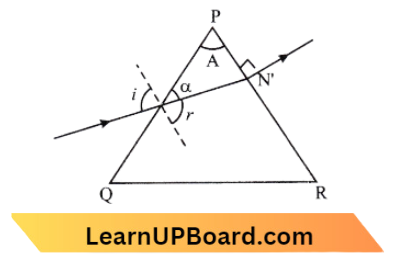
From the ray diagram,
⇒ \(\mathrm{A}+\alpha+90^{\circ} =180^{\circ}\)
⇒ \(\alpha =90^{\circ}-\mathrm{A}\)
Also \(r+\alpha =90^{\circ} \)
r =\(90^{\circ}-\alpha \)
⇒ \(90^{\circ}-\left(90^{\circ}-\mathrm{A}\right)\) =A
r =A
Also, From snell’s law \(\mu_1 \sin i=\mu_2 \sin r\)
⇒ \(\sin i=\mu \sin \mathrm{A}\) Here \(\mu_1=1 \mu_2=\mu)\)
For small, \(\sin \theta \approx \theta\)
i=\(\mu\) A.
Question 53. The refractive index of the material of a prism is V2 and the angle of the prism is 30°. One of the two refracting surfaces of the prism is made a mirror inwards, by silver coating. A beam of monochromatic light entering the prism from the other face will retrace its path (after reflection from the silvered surface) if its angle of incidence on the prism is:
- 30°
- 45°
- 60°
- zero
Answer: 2. 45°
Given
The refractive index of the material of a prism is V2 and the angle of the prism is 30°. One of the two refracting surfaces of the prism is made a mirror inwards, by silver coating.
For retracing its path, a light ray should be normally inclined on a silvered face.
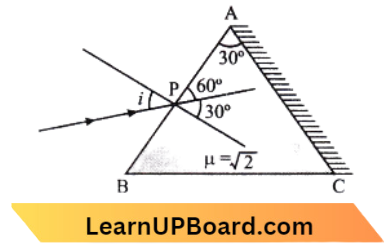
Applying Snell’s law at P,
⇒ \(\frac{\sin i}{\sin 30^{\circ}} =\frac{\sqrt{2}}{1}\)
⇒ \(\sin i =\sqrt{2} \times \frac{1}{2}=\frac{1}{\sqrt{2}}=\sin 45^{\circ}\)
i =\(45^{\circ}\)
Reflection and Refraction MCQs for NEET
Question 54. A thin prism having a refracting angle of 10° is made of glass with a refractive index of 1.42. This prism is combined with another thin prism of glass with a refractive index of 1.7. This combination produces dispersion without deviation. The refracting angle of the second prism should be:
- 4°
- 6°
- 8°
- 10°
Answer: 2. 6°
Given
A thin prism having a refracting angle of 10° is made of glass with a refractive index of 1.42. This prism is combined with another thin prism of glass with a refractive index of 1.7. This combination produces dispersion without deviation.
The dispersion without deviation of the prism is,
⇒ \((\mu-1) \mathrm{A}+\left(\mu^{\prime}-1\right) \mathrm{A}^{\prime}\) =0
⇒ \(|(\mu-1) \mathrm{A}| =\left|\left(\mu^{\prime}-1\right) \mathrm{A}^{\prime}\right| \)
⇒ \((1.42-1) =(1.7-1) \mathrm{A}^{\prime} \)
0.42 =0.7 \(\mathrm{~A}^{\prime} \)
∴ \(\mathrm{A}^{\prime} =6^{\circ}\)
Question 55. The angle of incidence for a ray of light at a refracting surface of a prism is 45°. The angle of the prism is 60°. If the ray suffers minimum deviation through the prism, the angle of minimum deviation and refractive index of the material of the prism respectively, are:
- \(30^{\circ} ; \sqrt{2}\)
- \(45^{\circ} ; \sqrt{2}\)
- \(30^{\circ} ; \frac{1}{\sqrt{2}}\)
- \(45^{\circ} ; \frac{1}{\sqrt{2}}\)
Answer: 1. \(30^{\circ} ; \sqrt{2}\)
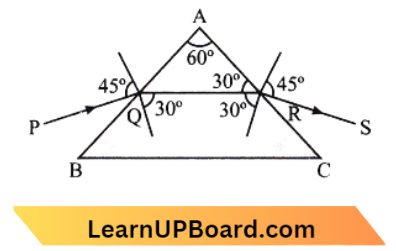
From the figure, it is clear that,
Here angle of incidence i=\(45^{\circ}\)
angle of refraction r=\(r^{\prime}=30^{\circ}\)
angle of emergence e=\(45^{\circ}\)
Minimum deviation suffered by the ray
⇒ \(u_d=i+e-\left(r+r^{\prime}\right)=90^{\circ}-60^{\circ}=30^{\circ}\)
Using the formula,
⇒ \(\mu=\frac{\sin \left(\frac{A+\delta}{2}\right)}{\sin \frac{A}{2}} \)
⇒ \(\mu=\frac{\sin \left(\frac{60^{\prime \prime}+30^{\prime \prime}}{2}\right)}{\sin \frac{60^{\prime \prime}}{2}}\)
⇒ \(\mu=\frac{\sin 45^{\prime \prime}}{\sin 30^{\prime \prime}}\)
∴ \(\mu=\frac{1 / \sqrt{2}}{1 / \mathrm{R}}=\frac{2}{\sqrt{2}}=\sqrt{2}\)
Reflection and Refraction MCQs for NEET
Question 56. The refracting angle of a prism is A, and the refractive index of the material of the prism is cot (A/2). The angle of minimum deviation is:
- 180° – 3A
- 180°-2A
- 90°-A
- 180° + 2A
Answer: 2. 180°-2A
We know that (from the prism formula)
⇒ \(\mu =\frac{\sin \left(\frac{A+\delta}{2}\right)}{\sin \left(\frac{A}{2}\right)} \)
⇒ \(\cot \frac{A}{2} =\frac{\sin \left(\frac{A+\delta}{2}\right)}{\sin \left(\frac{A}{2}\right)}\) …(Given)
⇒ \(\frac{\cos \left(\frac{A}{2}\right)}{\sin \left(\frac{A}{2}\right)} =\frac{\sin \left(\frac{A+\delta}{2}\right)}{\sin \left(\frac{A}{2}\right)}\)
⇒ \(\sin \left(\frac{\pi}{2}-\frac{A}{2}\right) =\sin \left(\frac{A}{2}+\frac{\delta}{2}\right)\)
=\(\pi-2 A\)
Question 57. A beam of light consisting of red, green, and blue colors is incident on a right-angled prism. The refractive index of the material of the prism for the above red, green, and blue wavelength are 1.9, 1.44, and 1.47, respectively. Blue Green Red The prism will:
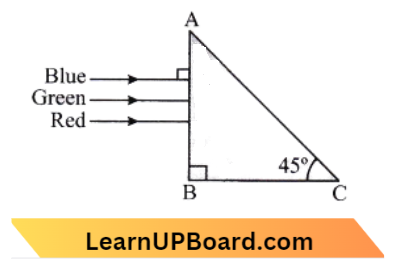
- separate the blue color part from the red and green colors
- separate all the three colors from one another
- not separate the three colors at all
- separate the red color part from the green and blue color.
Answer: 4. separate the red color part from the green and blue colors.
We know that, \(\mu =\frac{1}{\sin i_c}=\frac{1}{\sin 45^{\circ}}=\sqrt{2} \)
⇒ \(\ddots \left(\mu_{\text {red }}=1.39\right) <\mu \)
⇒ \(\mu_v >\mu ; \mu_g>\mu\)
only the red color does not suffer total internal reflection.
Question 58. The angle of the prism is A. One of its refracting surfaces is silvered. Light rays falling at an angle of incidence 2A on the first surface return back through the same path after suffering reflection at the silvered surface. The refractive index p, of the prism is:
- 2 sin A
- 2 cos A
- -cos A
- tan A
Answer: 2. 2 cos A
MOP is a prism and the diagram is given
⇒ \(\angle \mathrm{MON} =90-\mathrm{A}^{\circ} \)
⇒ \(\angle r =90-(90-\mathrm{A}) \)
⇒ \(\angle r =\mathrm{A}^{\circ}\)
From Snell’s law
⇒ \(\frac{\sin i}{\sin s} =\mu \)
⇒ \(\mu =\frac{\sin (2 \mathrm{~A})}{\sin \mathrm{A}} \)
⇒ \(\mu =\frac{2 \sin \mathrm{A} \cos \mathrm{A}}{\sin \mathrm{A}}=2 \cos \mathrm{A}\)
∴ \(\mu =2 \cos \mathrm{A}\)
Reflection and Refraction MCQs for NEET
Question 59. A ray of light is incident at an and le of incidence, I, on one face of a prism of angle A (assumed to be small) and emerges normally from the opposite face. If the refractive index of the prism is p the angle of incidence i, is nearly equal to:
- \(\mu \mathrm{A}\)
- \(\frac{\mu A}{2}\)
- \(\frac{A}{\mu}\)
- \(\frac{A}{2 \mu}\)
Answer: 1. \(\mu \mathrm{A}\)
According to the question,
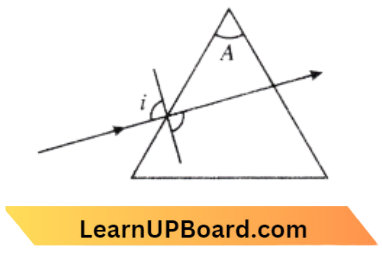
⇒ \(\mu=\frac{\sin i}{\sin r}=\frac{\sin i}{\sin \mathrm{A}}\)
If the angle is very small, then
⇒ \(\mu=\frac{i}{A}\)
i=\(\mu A\)
Question 60. For the angle of minimum deviation of a prism to be equal to its refracting angle, the prism must be made of a material whose refractive index:
- lies between \(\sqrt{2}\) and 1
- lies between 2 and \(\sqrt{2}\)
- is less than 1
- is greater than 2
Answer: 2. lies between 2 and \(\sqrt{2}\)
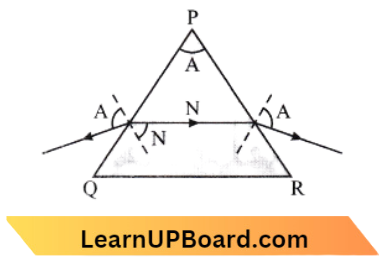
=\(\frac{\sin \left(\frac{A+A}{2}\right)}{\sin \frac{A}{2}}\)
Values of A varies from 0 to \(90^{\circ}\).
⇒ \(\mathrm{A}_{\min } =2 \cos \frac{90^{\circ}}{2}=\sqrt{2} \)
∴ \(\mathrm{~A}_{\max } =2 \cos 0^{\circ}\)=2
Lens and Mirror Formula MCQs NEET
Question 61. A thin prism of angle 15° made of glass of refractive index μ1= 1.5 is combined with another prism of glass of refractive index μ2 = 1.75. The combination of the prism produces dispersion without deviation. The angle of the second prism should be:
- 7°
- 10°
- 12°
- 5°
Answer: 2. 10°
The formula used without deviation is,
⇒ \(\frac{A}{A^{\prime}}=\frac{\mu^{\prime}-1}{\mu-1}\)
putting the given value from the question
⇒ \(\frac{15^{\circ}}{\mathrm{A}^{\prime}} =\frac{1.75-1}{1.5-1} \)
⇒ \(\frac{15}{\mathrm{~A}^{\prime}} =\frac{0.75}{0.5} \)
∴ \(\mathrm{A}^{\prime} =\frac{0.5 \times 15}{0.75}=10^{\circ}\)
Question 62. A ray of light is incident on a 60° prism at the minimum deviation position. The angle of refraction at the first face (i.e. incident face) of the prism is:
- zero
- 30°
- 45°
- 60°
Answer: 2. 45°
Here refracting angle of the prism
A=\(r_1+r_2\)
And for minimum deviation,
⇒ \(r_1 =r_2=r\)
A =2 r
r =\(\frac{A}{2}=\frac{60}{2}=30^{\circ}\)
Question 63. The refractive index of the material of a prism is V2 and its refracting angle is 30°. One of the refracting surfaces of the prism is made a mirror inward. A beam of monochromatic light entering the prism from the other face will retrace its path after reflection from the mirrored surface if its angle of incidence on the prism is:
- 45°
- 60°
- 0
- 30°
Answer: 1. 0
Here, \(\angle r=30^{\circ}\)
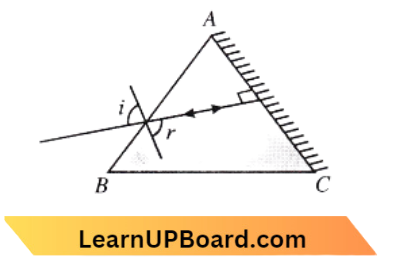
(Using the law of triangle)
⇒ \(\mu=\frac{\sin i}{\sin r}\)
⇒ \(\sqrt{2} \cdot \sin 30^{\circ}=\sin i \)
⇒ \(\sin i=\frac{1}{\sqrt{2}}\)
i=\(45^{\circ}\)
Lens and Mirror Formula MCQs NEET
Question 64. For the given incident ray as shown in the figure, the condition of the total internal reflection of this ray and the minimum refractive index of the prism will be:
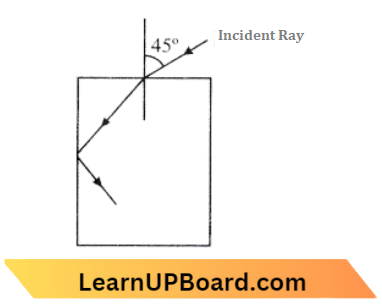
- \(\frac{\sqrt{3}+1}{2}\)
- \(\frac{\sqrt{2}+1}{2}\)
- \(\sqrt{\frac{3}{2}}\)
- \(\sqrt{\frac{7}{6}}\)
Answer: 3. \(\sqrt{\frac{3}{2}}\)
For given conditions and use Snell’s law

1.\(\sin 45^{\circ}=\mu \sin \left(90-\theta_C\right) \)
⇒ \(\frac{1}{\sqrt{2}}=\mu \cos \theta_C=\sqrt{u^2-1}\)
⇒ \(\mu^2=1+\frac{1}{2}=\frac{3}{2} \)
=\(\mu=\sqrt{\frac{3}{2}} \)
Lens and Mirror Formula MCQs NEET
Question 65. The angle of deviation (8) by a prism (refractive index = μ and supposing the angle of prism A to be small) can be given by
- \(\delta=(\mu-1) \mathrm{A}\)
- \(\delta=(\mu+1) \mathrm{A}\)
- \(\delta=\frac{\sin \frac{A+\delta}{2}}{\sin \frac{A}{2}}\)
- \(\delta=\frac{\mu-1}{\mu+1} \mathrm{~A}\)
Answer: 1. \(\delta=(\mu-1) \mathrm{A}\)
The refractive index of a prism is given by, Here,
⇒ \(\mu=\frac{\sin \frac{(\mathrm{A}+\delta)}{2}}{\sin \left(\frac{\mathrm{A}}{2}\right)}\)
For a very thin prism, we can assume that \(\sin \theta \approx \theta[//latex]
⇒ [latex]\mu=\frac{\frac{A+\delta}{2}}{\frac{A}{2}} \)
or \(\mu=\frac{A+\delta}{A} \)
Or, \(\delta=\mu \mathrm{A}-\mathrm{A}=(\mu-1) \cdot \mathrm{A}\)
Question 66. There is a prism with a refractive index equal to \(\sqrt{2}\) and a refracting angle equal to 30°. One of the refracting surfaces of the prism is polished. A beam of monochromatic will retrace its path if its angle of incidence over the refracting surface of the prism is.
- 0°
- 30°
- 45°
- 60°
Answer: 3. 45°
When the ray QR retraced its path,
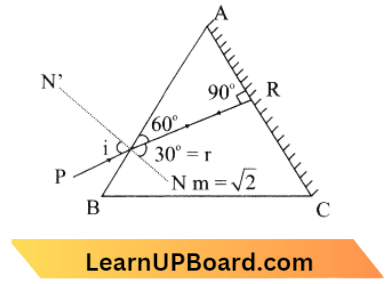
⇒ \(\angle A R Q =90^{\circ}, \angle r=30^{\circ}\)
⇒ \(\angle A Q R =90^{\circ}-30^{\circ}=60^{\circ}\)
By snell’s law, \(\sin i \times 1 =\sin \mathrm{r} \times \mu \)
⇒ \(\sin i =\mu \sin r=\sqrt{2} \sin 30^{\circ} [\mu for air =1]\)
Therefore, \(\sin i=\sqrt{2} \times \frac{1}{2}=\frac{1}{\sqrt{2}}\)
i=\(45^{\circ}\)
Question 67. Pick the wrong answer in the context of the rainbow :
- The order of colors is reversed in the secondary rainbow
- An observer can see a rainbow when his front is toward the sun
- Rainbow is a combined effect of dispersion and reflection of sunlight
- When the light rays undergo two internal reflections in a water drop, a secondary rainbow is formed.
Answer: 2. An observer can see a rainbow when his front is towards the sun
Rainbows cannot be observed when the observer faces toward the sun.
Lens and Mirror Formula MCQs NEET
Question 68. The reddish appearance of the sun at sunrise and sunset is due to:
- the scattering of light
- the polarization of light
- the color of the sun
- the color of the sky
Answer: 1. the scattering of light
The reddish appearance of the sun at sunrise and sunset is due to the scattering of light.
Question 69. Rainbows are formed by:
- reflection and diffraction
- refraction and scattering
- dispersion and total internal reflection
- interference only
Answer: 3. dispersion and total internal reflection
When white light from the sun falls on raindrops, a band of different colors appears in the sky in the shape of a circular arc. This phenomenon is called a rainbow. It is due to that the little drops of water act as prisms for the white sunlight, causing refraction, dispersion, and total internal reflection of white light. The rainbow is not visible after every rain, and often when light rays of a specific color deviate minimally after one or two total internal reflections inside minuscule water drops.
Question 70. A lens of large focal length and large aperture is best suited as an objective of an astronomical telescope since:
- a large aperture contributes to the quality and visibility of the images.
- a large area of the objective ensures better light-gathering power.
- a large aperture provides a better resolution
- all of these
Answer: 4. all of these
Aperture ensure proper collection of light as well as better resolution.
Question 71. Assume that, light of wavelength 600 nm is coming from a star. The limit of resolution of a telescope whose objective has a diameter of 2 m is:
- 183 \(\times 10^{-7} \mathrm{rad}\)
- 7.32 \(\times 10^{-7} \mathrm{rad}\)
- 6.00 \(\times 10^{-7} \mathrm{rad}\)
- 3.66 \(\times 10^{-7} \mathrm{rad}\)
Answer: 4. 3.66 \(\times 10^{-7} \mathrm{rad}\)
Given the wavelength of light
⇒ \(\lambda =600 \mathrm{~nm} \)
= \(600 \times 10^{-9} \mathrm{~m}\)
Diameter of objective d=2 \(\mathrm{~m}\)
Limit of resolution telescope
d \(\theta =\frac{1.22 \times 600 \times 10^{-9}}{2} \)
=3.66 \(\times 10^{-7} \mathrm{rad}\) .
Lens and Mirror Formula MCQs NEET
Question 72. An astronomical refracting telescope will have large angular magnification and high angular resolution when it has an objective lens of:
- large focal length and large diameter
- large focal length and small diameter
- small focal length and large diameter
- small focal length and small diameter
Answer: 1. large focal length and large diameter
For telescope, angular magnification of. So focal M = \(\frac{f_0}{f_e}\) length of the objective lens should be large. And Angular resolution = \(\frac{D}{1.22 \lambda}\)should be large.S
So objective should have a large focal length \(\left(f_0\right)\) and a large diameter (D). The option (a) is Correct. [Means objective lens should have large focal length \(\left(f_0\right)\) and large diameter (0)]
Question 73. The ratio of resolving powers of an optical microscope for two wavelengths λ1= 4000 Å and λ2 = 6000 Å is:
- 8:27
- 9: 4
- 3:2
- 16: 81
Answer: 3. 3:2
Resolving power of microscope,
(R.P) \(\propto \frac{1}{\lambda_{\text {(wavelength) }}}\)
∴ \(\frac{\mathrm{RP}_1}{\mathrm{RP}_2}=\frac{\lambda_2}{\lambda_1}=\frac{6000}{4000}=\frac{3}{2}\)
Question 74. An astronomical telescope has an objective and eyepiece of focal lengths of 40 cm and 4 cm respectively. To view an object 200 cm away from the objective, the lens must be separated by a distance:
- 46.0 cm
- 50.0 cm
- 54.0 cm
- 37.3 cm
Answer: 3. 54.0 cm
Using lens formula for the objective lens
⇒ \(\frac{1}{v}-\frac{1}{u} =\frac{1}{f} \)
⇒ \(\frac{1}{v} =\frac{1}{f}+\frac{1}{u}\)
= \(\frac{1}{40}+\frac{1}{-200}\)
= \(\frac{+5-1}{200} \)
v =50 cm
Tube length =l=\(|v|+f_e \)
=50+4
=54 cm
Lens and Mirror Formula MCQs NEET
Question 75. In an astronomical telescope in normal adjustment a straight black line of length L is drawn on the inside part of the objective lens, the eye-piece forms a real image of this line. The length of this image is l. Then magnification of the telescope is:
- \(\frac{L}{l}+1\)
- \(\frac{L}{l}-1\)
- \(\frac{L+1}{L-1}\)
- \(\frac{L}{l}\)
Answer: 4. \(\frac{L}{l}\)
We know that the magnification of a telescope,
M=\(\frac{f_0}{f_0}/[latex] → Equation 1
And also [latex]\frac{f_e}{f_e+u}=-\frac{l}{L}\)
⇒ \(\frac{f_e}{f_e-\left(f_0+f_e\right)} =-\frac{l}{L}\)
⇒ \(\frac{f_e}{f_0} =\frac{l}{L}\) → Equation 2
From eq. (1) and (2),
M=\(\frac{L}{l}\)
Question 76. A microscope is focused on a mark on a piece of paper and then a slab of glass of thickness 3 cm and a refractive index of 1.5 is placed over the mark. How should the microscope be moved to get the mark in focus again?
- 2 cm upward
- 1 cm upward
- 4.5 cm downward
- 1 cm downward
Answer: 2. 1 cm upward
Shifting in microscope = upward shifting in mark
t\(\left(1-\frac{1}{\mu}\right)=3\left(1-\frac{1}{1.5}\right)=1 \mathrm{~cm}\)
Question 77. The angular resolution of a 10 cm diameter telescope at a wavelength of 5000 A is of the order of:
- \(10^6 \mathrm{rad}\)
- \(10^{-2} \mathrm{rad}\)
- \(10^{-4} \mathrm{rad}\)
- \(10^{-6} \mathrm{rad}\)
Answer: 4. \(10^{-6} \mathrm{rad}\)
Here, R.P. =\(\frac{1}{\Delta \theta}\)
Angular resolution, \(\Delta \theta =\frac{1.22 \lambda}{\mathrm{D}}\)
= \(\frac{1.22 \times 5000 \times 10^{-10}}{0.1}\)
= \(6.10 \times 10^{-6} \)
∴ \(\cong 10^{-6}\)
Lens and Mirror Formula MCQs NEET
Question 78. A telescope has an objective lens of 10 cm diameter and is situated at a distance of one kilometer from two objects. The minimum distance between these two objects, which can be resolved by the telescope, when the mean wavelength of light is 5000 A, is of the order of:
- 0.5 m
- 5 m
- 5 mm
- 5 cm
Answer: 3. 5 mm
According To Question, \(\theta =\frac{1.22}{a} \lambda \)
⇒ \(\frac{d}{D} =\frac{\lambda}{\mathrm{a}} \)
⇒ \(a^{\prime} =\frac{\lambda D}{a} \)
a =\(\frac{5000 \times 10^{-10} \times 10^3}{10 \times 10^{-2}}=5 \mathrm{~mm}\)
Question 79. The diameter of the human eye lens is 2 mm. What will be the minimum distance between two points to resolve them, which are situated at a distance of 50 m from the eye? The wavelength of light is 5000 Å.
- 2.32 m
- 4.28 mm
- 1.25 cm
- 12.48 cm
Answer: 3. 1.25 cm
For the aperture, limit of resolution
⇒ \(\frac{y}\geq \frac{\lambda}{d} \)
y \(\geq \frac{\lambda D}{d} \)
y \(\geq \frac{5 \times 10^{-7}}{2 \times 10^{-3}} \times 50 \geq 1.25 \mathrm{~m}\)
Question 80. An astronomical telescope of ten-fold angular magnification has a length of 44 cm. The focal length of the objective is:
- 440 cm
- 44 cm
- 40 cm
- 4 cm
Answer: 3. 44 cm
For an astronomical telescope,
Therefore, m=\(\frac{f_0}{f_e}\)
where,f_0= focal length of objective lens,
f_e= focal length of eyepiece lens
Length of telescope tube, L=\(f_{\mathrm{o}}+f_{\mathrm{e}}\)
m=10, L=44 \(\mathrm{~cm}\)
⇒ \(\frac{f_0}{f_e}\)=10
and \(f_o+f_e\)=44
⇒ \(f_o=\frac{f_e}{10}\)
⇒ \(f_o+\frac{f_0}{10}\)=44
or –\(\frac{11 f_0}{10}\)=44
or \(f_o=40 \mathrm{~cm}\)
